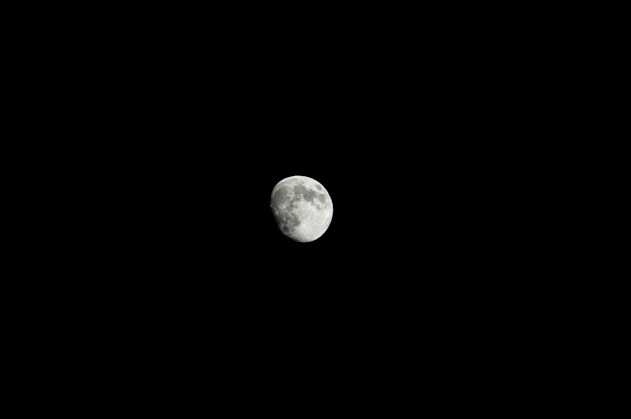
New AutoStar, so it was Cloudy
On Tuesday, 19 October, I received my new AutoStar II Wireless Handbox from OPT. And of course, the sky was cloudy. But that gave me an opportunity to test it and a new SkyFi Wi-Fi adapter. I opened the observatory at 1810 MST, 73°F, under mostly cloudy skies. There were a few holes in the clouds at times. I managed to capture this image of the moon with the D70 DSLR at prime focus + 3X TeleXtender, ISO 200, at 1837 MST. through a thin cloud:

At 1900 MST, I began working with the SkyFi and SkySafari 2.0 on the iPhone 4. The Wi-Fi connection problems I had with the first unit seem to be resolved in this replacement unit. The iPhone would reliably connect to the SkyFi network when being awakened from its sleep mode. By the way, Carina Mobile SkyVoyager and SkyGazer iOS apps have been renamed to SkySafari and SkySafari Lite as of the new 2.0 versions. The company name has been changed to Southern Stars (http://www.southernstars.com/).
At 1920 MST, there was a large hole in the clouds so I took the opportunity to capture this photo of the waxing gibbous moon with the D70 DSLR, 300mm, 1/320sec, f/13, ISO 500:

I then hooked up the AutoStar II Wireless Handbox. It does not use Wi-Fi so there was no interference or configuration issue with the SkyFi. The wireless AutoStar II is a full replacement for the wired model. There is a small transceiver that connects to the HBX port on the LX200-ACF base (where the wired AutoStar II is normally connected). A small piece of Velcro is supplied to secure the transceiver but I didn’t use it. The wireless AutoStar II worked perfectly. It was nice to not be tied to the telescope when holding the AutoStar II. (I guess using the SkyFi Wi-Fi adapter has spoiled me.) There were no worries about a handcontroller cable catching on anything. The wireless AutoStar II is slightly heavier than the wired model, probably due to the 4 AA batteries and the extra circuitry required. Meade says the batteries should last about 40 hours, which, for me, isn’t very many nights. I will probably switch to using rechargeable AA batteries. I thought about adding a Velcro strip on the back of the wireless AutoStar II, like I did with the wired model to secure it to a tripod leg when not in use. However, the wireless model has a curved back, which would mean that only a small section of the Velcro would grab the piece on the tripod leg. That didn’t seem like it would be secure enough, especially with the heavier wireless model. I decided that this would not be a problem as the wireless model can be placed almost anywhere there’s a flat surface. And it can even be placed in a large pocket when not in use (which will keep it warm in the winter months). I did discover one oddity: the I.C. objects key is labeled “L.C.”. It is correctly labeled on the wired AutoStar II. For some reason, Meade moved the ENTER, MODE, and GOTO keys to the bottom of the wireless AutoStar II (they are on the top on the wired model) and the SCROLL-UP, SCROLL-DOWN, and ? keys to the top (they are on the bottom on the wired model). This re-arrangement will take some getting used to after using the former arrangement since 1999 (the ETX AutoStar and LX200 wired AutoStar II have the same key arrangements). But I expect that I will quickly adapt to the re-arrangement once the skies clear and I can spend a few nights using the AutoStar II Wireless Handbox.
I closed the observatory, under overcast skies, at 2005 MST, 63°F.
When I got back to the house, I received the great news that a Nikon D7000 DSLR with my name on it is at OPT!!! The extra battery and AC adapter cable that I also ordered are on backorder from Nikon.
I have complained to Nikon for some time about their DSLR camera model naming scheme; there is no logic to it. Their model number sequence like D3, D90, D300, D5000, does not indicate an “order-of-magnitude” increase from one model to the next. In fact, there is no capability sequence indicated by the model numbers. However, with the D7000 DSLR they got it right. It is definitely two orders-of-magnitude better than my D70 DSLR. I look forward to learning to use the new camera and doing general photography and astrophotography with it. Stay tuned!
Wednesday, October 20, 2010

